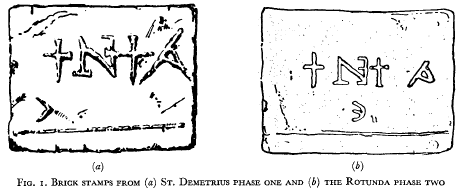No CrossRef data available.
Published online by Cambridge University Press: 27 September 2013
There are several buildings at Thessaloniki that can be dated to the middle or second half of the fifth century A.D. and which have one feature in common, namely, the characteristic brick stamps illustrated in Figs, 1a and b. Bricks bearing these stamps occur in the following buildings: Acheiropoietos, the first phase of St. Demetrius, the city walls, and the second phase of the Rotunda. The conventional date for the Acheiropoietos basilica is c. 470 and for the first phase of St. Demetrius some time between 450 and 500. The dates usually given to the walls and the Rotunda are c. 380/390, but I have recently shown that the walls ought to be dated to around the middle of the fifth century and that phase two of the Rotunda belongs with the fifth-century churches. I hope to demonstrate that the Byzantine palace was also built at about the same period.

Acknowledgements. I am grateful to Professor R. M. Harrison and Dr. W. H. Plommer for reading through a draft of this note and making suggestions for its improvement.
1 Fig. 1 a is taken from Soteriou, G. and Soteriou, M., Ἡ Βασιλκὴ τοῦ Ἁγίου Δημητρίου Θεσσαλονίκης (Athens, 1952) 116 fig. 43aGoogle Scholar; and 1b from Hébrard, E., BCH xliv (1920) 32Google Scholar (bottom).
2 Acheiropoietos: Tafrali, O., Topographie de Thessalonique (Paris, 1913) 151–3Google Scholar; St. Demetrius: G. and M. Soteriou, loc. cit. and pl. 94b; city walls: Tafrali, op. cit. 76–7; Rotunda, : BCH xliv (1920) 31–2.Google Scholar
3 Acheiropoietos: Krautheimer, R., Early Christian and Byzantine Architecture (Harmondsworth, 1965) 74–5 and 94Google Scholar; St. Demetrius: G. and M. Soteriou, op. cit. 247.
4 e.g. Theocharides, G., Τοπογραφία καὶ πολιτικὶ ἱστορία τῆς Θεσσαλονίκης κατὰ τὸν ΙΔ′ αἰῶνα (Thessaloniki, 1959) 16Google Scholar; Letsas, A. N., Ἱστορία τῆς Θεσσαλονίκης (Thessaloniki, 1961) 39Google Scholar; Vacalopoulos, A. E., A History of Thessaloniki (Thessaloniki, 1963) 24Google Scholar; Torp, H., Mosaikkene i St Georg-Rotunden i Thessaloniki (Oslo, 1963) 12Google Scholar; Papahadjis, N., Monuments of Thessalonike, 3rd edn. (Thessaloniki, 1968) 4 and 8Google Scholar; and Vickers, M. in Symposium on Ancient Macedonia 1968 (Thessaloniki, 1970) 250.Google Scholar
5 Vickers, M., ‘The date of the walls of Thessalonica’, Istanbul Arkeoloji Müzeleri Yilliği xv–xvi (1969) 313–18Google Scholar and ‘The Late-Roman walls of Thessalonica’ in the forthcoming Transactions of the 8th International Congress of Roman Frontier Studies, Cardiff/Birmingham, 1969.
6 Vickers, M., ‘The date of the mosaics of the Rotunda at Thessaloniki’, BSR xxxv (1970) 183–7.Google Scholar
7 Chalfa, Mustafa Ben Abdalla Hadschi, Rumeli und Bosna, trans. by Hammer, J. (Vienna, 1812) 77Google Scholar: ‘Die Moskée des Seraj, zu den Zeiten der Ungläubigen, die Hofkirche.’
8 Papageorgiou, P. N., ‘Ἀρχαία εἰκαίν τοῦ Ἁγίου Δημητρίου’ ByzZeit i (1892) 482.Google Scholar
9 Theocharides, G., ‘Δύο νέα ἔγγραφα ἀφορῶντα εὴν Νέαν Μονὴν Θεσσαλονίκης’, Makedonika iv (1960) 347–8.Google Scholar
10 The best account of the literary evidence for Nea Moni is to be found in Theocharides, , ‘Ἡ Νέα Μονὴ Θεσσαλονίκης’ Makedonika iii (1953–1935) 334–9.Google Scholar He was the first to connect Nea Moni with Prophitis Elias in Makedonika iv, loc. cit.
11 The present name is of no great antiquity, but according to Theocharides, (Makedonika iv. 346)Google Scholar came about as the result of a false etymology: Saxayh Carni becoming Aï Elias.
12 Texier, C. and Pullan, R. P., Byzantine Architecture (London, 1864) 150.Google Scholar
13 An interesting parallel for this is also to be found ibid. 145. Texier found brick stamps of the type described ‘in the pavement of the women's gallery’ of St. Sophia which, it has recently been discovered (ADelt xvii (1961–2) Chronika 253–6; and xviii (1963) Chronika 235–40), was built on the site of an earlier fifth-century church, whence, presumably, the bricks came.
14 Justinian, , Novella xi (ed. Schoell, –Kroll, , 94)Google Scholar and Theodoret, , Eccles. Hist. v. 17, 1 (ed. Gaisford, , 430)Google Scholar cited by Lemerle, P., Philippes et la Macédoine orientale (Paris, 1945) 82–3.Google Scholar My thanks are due to Dr. Robin Cormack for this reference.
15 I am grateful to Mr. W. E. Kleinbauer for reminding me of this.
16 ADelt xx (1965) Chronika 409.
17 PAE 1950, 304.
18 See my observations in Transactions (n. 5).
19 ‘Kurzer vorläufiger Bericht über die Ausgrabungen im Palastviertel von Thessaloniki, 1939’, Laureae Aquincenses Val. Kuzsinsky dicatae ii, Dissertationes Pannonicae, 2nd ser. xi (Budapest, 1941) 69. It might be objected that a southern main entrance to the second phase of the Rotunda indicates that there was still a palace to the south; otherwise, an East Door would have been inserted. But it should be remembered that there was still a colonnaded street leading up from the Arch of Galerius and the city's principal artery, which people visiting the church would have used; the continued existence of the colonnaded street surely governed the position of the main entrance.